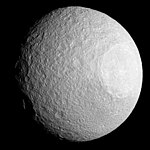Telesto (moon)
 Telesto as seen by the Cassini probe on 11 October 2005 | |
| Discovery | |
|---|---|
| Discovered by |
|
| Discovery date | April 8, 1980 |
| Designations | |
Designation | Saturn XIII |
| Pronunciation | /təˈlɛstoʊ/ |
Named after | Τελεστώ Telestō |
| Tethys B S/1980 S 13 | |
| Adjectives | Telestoan /tɛləˈstoʊ.ən/ or Telestoian /tɛləˈstoʊ.iən/ |
| Orbital characteristics | |
| 295000 km[1] | |
| Eccentricity | 0.001[1] |
| 1.887802 d[1] | |
| Inclination | 1.19° (to Saturn's equator) |
| Satellite of | Saturn |
| Group | L4 Tethys trojan |
| Physical characteristics | |
| Dimensions | 33.2 × 23.4 × 19.2 km (± 0.6 × 0.6 × 0.4 km)[2]: 2 |
| 24.6±0.6 km[2]: 2 | |
| Volume | 7795 km3[a] |
| Mass | ≈ 4×1015 kg (assumed; unmeasured)[b] |
Mean density | ≈ 0.5 g/cm3 (assumed; unmeasured)[2]: 3 |
| ≈ 0.0011–0.0014 m/s2[2]: 3 | |
| ≈ 0.006 km/s at longest axis to ≈ 0.007 km/s at poles | |
| zero | |
| 18.7[3] | |
Telesto /təˈlɛstoʊ/ is a moon of Saturn. It was discovered by Smith, Reitsema, Larson and Fountain in 1980 from ground-based observations, and was provisionally designated S/1980 S 13.[4] In the following months, several other apparitions were observed: S/1980 S 24,[5] S/1980 S 33,[6] and S/1981 S 1.[7]
In 1983 it was officially named after Telesto of Greek mythology.[c] It is also designated as Saturn XIII or Tethys B.
Telesto is co-orbital with Tethys, residing in Tethys' leading Lagrangian point (L4). This relationship was first identified by Seidelmann et al. in 1981.[8] Another moon, Calypso, resides in the other (trailing) Lagrangian point of Tethys, 60 degrees in the other direction from Tethys. The Saturnian system has two additional trojan moons.
Exploration
[edit]The Cassini probe performed a distant flyby of Telesto on October 11, 2005. The resulting images show that its surface is surprisingly smooth, devoid of small impact craters.
Notes
[edit]- ^ Calculated from Telesto's volume-equivalent sphere radius of 12.3±0.3 km given by Thomas et al. (2020)[2]: 2
- ^ Calculated by multiplying Telesto's volume with its assumed density of 500 kg/m3.
- ^ Transactions of the International Astronomical Union, Vol. XVIIIA, 1982 (confirms Janus, names Epimetheus, Telesto, Calypso) (mentioned in IAUC 3872)
References
[edit]Citations
[edit]Sources
[edit]- Hamilton, Calvin J. "Saturn's Trojan Moon Telesto". SolarViews.com. SolarViews. Retrieved 2011-12-23.
- Marsden, Brian G. (April 10, 1980). "Satellites of Saturn" (discovery). IAU Circular. 3466. Retrieved 2011-12-23.
- Marsden, Brian G. (June 6, 1980). "Satellites of Saturn". IAU Circular. 3484. Retrieved 2011-12-23.
- Marsden, Brian G. (April 16, 1981). "Satellites of Saturn". IAU Circular. 3593. Retrieved 2011-12-23.
- Marsden, Brian G. (May 18, 1981). "Satellites of Saturn". IAU Circular. 3605. Retrieved 2011-12-23.
- Marsden, Brian G. (September 30, 1983). "Satellites of Jupiter and Saturn". IAU Circular. 3872. Retrieved 2011-12-23.
- Seidelmann, P. K.; Harrington, R. S.; Pascu, D.; Baum, W. A.; Currie, D. G.; Westphal, J. A.; Danielson, G. E. (1981). "Saturn satellite observations and orbits from the 1980 ring plane crossing". Icarus. 47 (2): 282. Bibcode:1981Icar...47..282S. doi:10.1016/0019-1035(81)90172-X.
- Thomas, P. C. (July 2010). "Sizes, shapes, and derived properties of the saturnian satellites after the Cassini nominal mission" (PDF). Icarus. 208 (1): 395–401. Bibcode:2010Icar..208..395T. doi:10.1016/j.icarus.2010.01.025. Archived from the original (PDF) on 2011-09-27. Retrieved 2015-09-04.
- Thomas, P. C.; Helfenstein, P. (July 2020). "The small inner satellites of Saturn: Shapes, structures and some implications". Icarus. 344: 20. Bibcode:2020Icar..34413355T. doi:10.1016/j.icarus.2019.06.016. S2CID 197474587. 113355.

